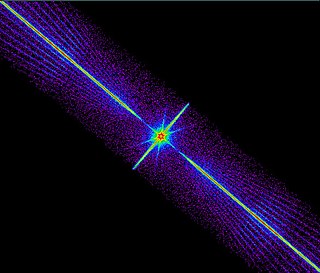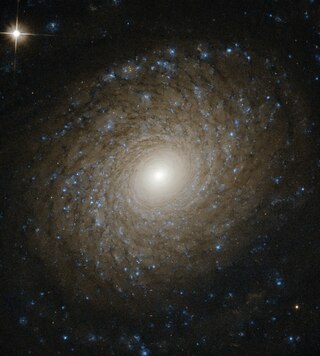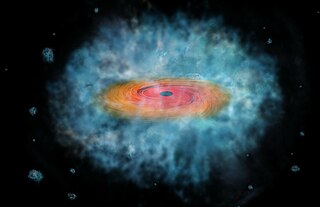
Cygnus X-1 (abbreviated Cyg X-1) is a galactic X-ray source in the constellation Cygnus and was the first such source widely accepted to be a black hole. It was discovered in 1971 during a rocket flight and is one of the strongest X-ray sources detectable from Earth, producing a peak X-ray flux density of 2.3×10−23 W/(m2⋅Hz) (2.3×103 jansky). It remains among the most studied astronomical objects in its class. The compact object is now estimated to have a mass about 21.2 times the mass of the Sun and has been shown to be too small to be any known kind of normal star or other likely object besides a black hole. If so, the radius of its event horizon has 300 km "as upper bound to the linear dimension of the source region" of occasional X-ray bursts lasting only for about 1 ms.
A Thorne–Żytkow object, also known as a hybrid star, is a conjectured type of star wherein a red giant or red supergiant contains a neutron star at its core, formed from the collision of the giant with the neutron star. Such objects were hypothesized by Kip Thorne and Anna Żytkow in 1977. In 2014, it was discovered that the star HV 2112, located in the Small Magellanic Cloud (SMC), was a strong candidate. Another possible candidate is the star HV 11417, also located in the SMC.

Norma is a small constellation in the Southern Celestial Hemisphere between Ara and Lupus, one of twelve drawn up in the 18th century by French astronomer Nicolas-Louis de Lacaille and one of several depicting scientific instruments. Its name is Latin for normal, referring to a right angle, and is variously considered to represent a rule, a carpenter's square, a set square or a level. It remains one of the 88 modern constellations.

A supermassive black hole is the largest type of black hole, with its mass being on the order of hundreds of thousands, or millions to billions of times the mass of the Sun (M☉). Black holes are a class of astronomical objects that have undergone gravitational collapse, leaving behind spheroidal regions of space from which nothing can escape, not even light. Observational evidence indicates that almost every large galaxy has a supermassive black hole at its center. For example, the Milky Way has a supermassive black hole in its Galactic Center, corresponding to the radio source Sagittarius A*. Accretion of interstellar gas onto supermassive black holes is the process responsible for powering active galactic nuclei (AGNs) and quasars.
Cygnus X-3 is a high-mass X-ray binary (HMXB), one of the stronger binary X-ray sources in the sky. It is often considered to be a microquasar, and it is believed to be a compact object in a binary system which is pulling in a stream of gas from an ordinary star companion. It is one of only two known HMXBs containing a Wolf-Rayet star. It is invisible visually, but can be observed at radio, infrared, X-ray, and gamma-ray wavelengths.
The Tolman–Oppenheimer–Volkoff limit is an upper bound to the mass of cold, non-rotating neutron stars, analogous to the Chandrasekhar limit for white dwarf stars. If the mass of a neutron star reaches the limit it will collapse to a denser form, most likely a black hole.

LS 5039 is a binary system in the constellation of Scutum. It has an apparent magnitude of 11.27, and it is about 8,200 light-years away.

GRS 1915+105 or V1487 Aquilae is an X-ray binary star system which features a regular star and a black hole. It was discovered on August 15, 1992 by the WATCH all-sky monitor aboard Granat. "GRS" stands for "GRANAT source", "1915" is the right ascension and "105" reflects the approximate declination. The near-infrared counterpart was confirmed by spectroscopic observations. The binary system lies 11,000 parsecs away in Aquila. GRS 1915+105 is the heaviest of the stellar black holes so far known in the Milky Way Galaxy, with 10 to 18 times the mass of the Sun. It is also a microquasar, and it appears that the black hole rotates at least 950 times per second, close to the maximum of 1,150 times per second, with a spin parameter value between 0.82 and 1.00.

HU Aquarii is an eclipsing binary system approximately 620 light-years away from the Sun, forming a cataclysmic variable of AM Herculis-type. The two stars orbit each other every 2.08 hours and the ultra-short binary system includes an eclipsing white dwarf and red dwarf.

XTE J1118+480 is a low-mass X-ray binary in the constellation Ursa Major. It is a soft X-ray transient that most likely contains a black hole and is probably a microquasar.

NGC 4026 is an edge-on lenticular galaxy in the constellation Ursa Major. It is located at a distance of circa 50 million light years from Earth, which, given its apparent dimensions, means that NGC 4026 is about 80,000 light years across. It was discovered by William Herschel on April 12, 1789.

NGC 7213 is a lenticular galaxy located in the constellation Grus. It is located at a distance of circa 70 million light-years from Earth, which, given its apparent dimensions, means that NGC 7213 is about 75,000 light-years across. It was discovered by John Herschel on September 30, 1834. It is an active galaxy with characteristics between a type I Seyfert galaxy and LINER.

NGC 2985 is a spiral galaxy located in the constellation Ursa Major. It is located at a distance of circa 70 million light years from Earth, which, given its apparent dimensions, means that NGC 2985 is about 95,000 light years across. It was discovered by William Herschel on April 3, 1785.

NGC 4278 is an elliptical galaxy located in the constellation Coma Berenices. It is located at a distance of circa 55 million light years from Earth, which, given its apparent dimensions, means that NGC 4278 is about 65,000 light years across. It was discovered by William Herschel on March 13, 1785. NGC 4278 is part of the Herschel 400 Catalogue and can be found about one and 3/4 of a degree northwest of Gamma Comae Berenices even with a small telescope.

NGC 4299 is a featureless spiral galaxy located about 55 million light-years away in the constellation Virgo. It was discovered by astronomer William Herschel on March 15, 1784 and is a member of the Virgo Cluster.

NGC 4312 is an edge-on unbarred spiral galaxy located about 55 million light-years away in the constellation Coma Berenices. It was discovered by astronomer William Herschel on January 14, 1787. NGC 4312 is a member of the Virgo Cluster and is a LINER galaxy.

NGC 4313 is an edge-on spiral galaxy located about 50 million light-years away in the constellation Virgo. It was discovered by astronomer William Herschel on March 15, 1784. NGC 4313 is a member of the Virgo Cluster and is classified as LINER and as a Seyfert galaxy.

Direct collapse black holes are high-mass black hole seeds, putatively formed within the redshift range , when the Universe was about 100–250 million years old. Unlike seeds formed from the first population of stars (also known as Population III stars), direct collapse black hole seeds are formed by a direct, general relativistic instability. They are very massive, with a typical mass at formation of ~105 M☉. This category of black hole seeds was originally proposed theoretically to alleviate the challenge in building supermassive black holes already at redshift , as numerous observations to date have confirmed.

UX Ursae Majoris is an Algol type binary star system in the northern circumpolar constellation of Ursa Major. It is classified as a nova-like variable star similar to DQ Herculis, although no eruptions have been reported. Since its discovery in 1933, this system has been the subject of numerous studies attempting to determine its properties. The combined apparent visual magnitude of UX UMa ranges from 12.57 down to 14.15. The system is located at a distance of approximately 952 light years from the Sun based on parallax, and is drifting further away with a radial velocity of 112 km/s.
















